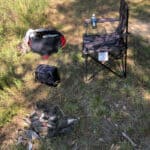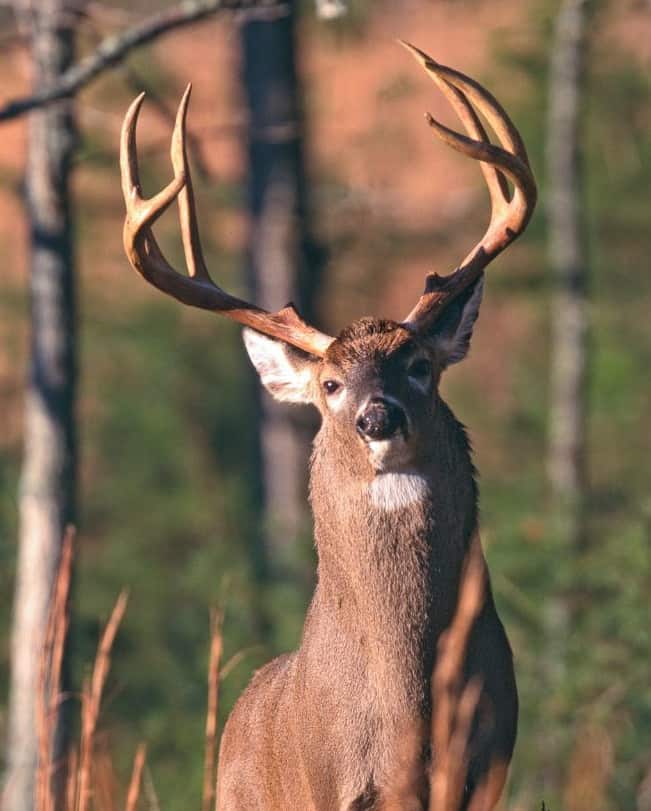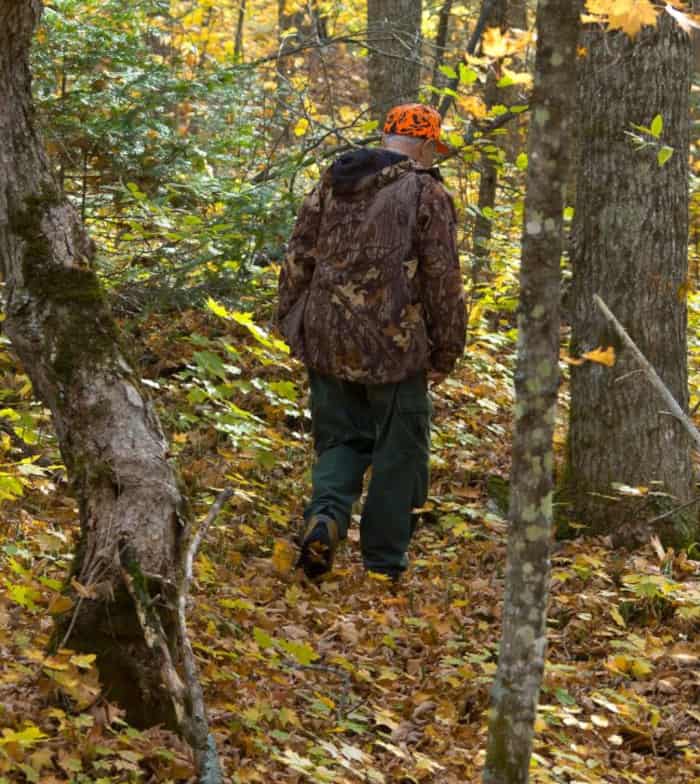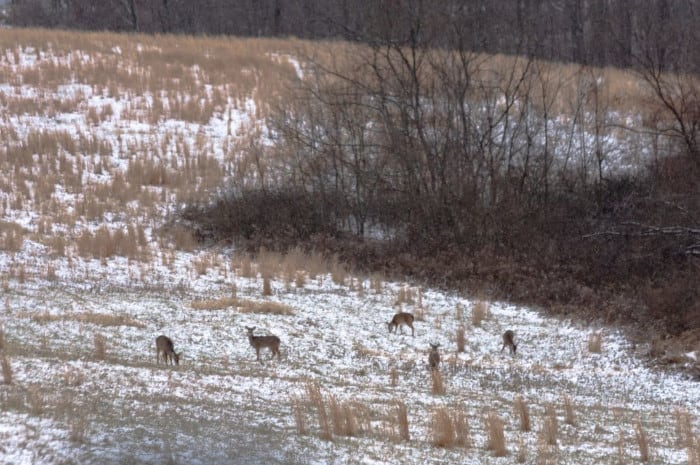Introducing a youth or teenager to deer hunting is always a worthwhile venture and well worth your time. However, along with the preparation for that first deer hunt comes the challenge of choosing a rifle caliber that will do the job but doesn’t have so much recoil that the experience becomes unpleasant. Since the topic of best calibers for new deer hunters comes up so much at my day job in the hunting industry, here are my suggestions for the 8 best youth deer rifle caliber recommendations with the least amount of recoil.

Not only did I go through the same caliber selection process when introducing my kids to deer hunting, but I’ve also worked with several local hunting groups focusing on introducing kids to hunting. Since I manage a few hunting properties and participate in whitetail management principles, I generally need to do some doe harvesting each year to maintain ideal buck-to-doe ratios on those properties. For the doe culling, I usually try to host youths or young children with their parents who are looking to harvest their first deer.
In addition to having been involved with introducing many kids and youth to the sport, I’m also going share some specific details of experiences with my kids, including a failure on my part with one of my sons.
My First Experience With Recoil as a Teenager
I grew up the North Carolina in a family that enjoyed the outdoors. My father’s side of the family was the avid hunting side, and my mother’s side was more into fishing. While my father was an avid hunter, he preferred hunting small game over deer and turkey. However, several of my uncles from my father’s side were big deer hunting fans. My first experience deer hunting as a hunter happened when I was 13. I had been gifted a Winchester 30-30 lever action for Christmas and harvested my first deer (a doe) two days later.
The 30-30 was a very popular caliber where I grew up and was a good choice for a young deer hunter just getting started since it had a very mild recoil. The following deer season, I hunted the opening day of rifle season with an uncle, hoping to bag something with antlers. I ended up shooting a small 6-pointer but didn’t make a very good shot. Although we followed his blood trail for nearly 100 yards, he made it into a thick, briar-filled thicket, and was never recovered.
The uncle I hunted with felt like the 30-30 was too light for deer, and he urged me to try his bolt action 30-06 the next time we hunted. Now, the 30-06 was a very popular caliber in those days and was commonly used for deer in North Carolina. So the following Saturday, he and I returned to the same deer stand, and he basically talked me into shooting his 30-06 should another buck come along.
Now, I had not previously fired this hunting rifle, so I had no prior experience with it. However, he assured me that the recoil “wasn’t bad” and it would do a far better job of downing a deer compared to my 30-30. So, since I was eager to harvest my first buck, I took him at his word and decided to use the 30-06 on the next buck.
A small 4-pointer showed up, and I decided to take a shot at him at about 75 yards. I rested the rifle on the windowsill of the box blind we were in, centered the scope crosshairs on his shoulder, and gently squeezed the trigger.
When I pulled the trigger, the recoil drove the rifle backwards to the point where the scope actually struck me in the face just above my right eye. And I don’t mean a minor glancing blow; I mean a solid direct-on-whack just above my eye. The recoil was waaay worse than I anticipated, and it actually hurt my shoulder. To make matters worse, I completely missed the deer.
Right after I shot, I recall two things standing out in my mind:
- I never wanted to shoot his rifle again.
- My uncle had lied about the recoil, and I didn’t want to hunt with him again.
That particular bad experience impacted me in several ways:
First and foremost, I no longer trusted that particular uncle, and it was at least 5-7 years before I ever hunted with him again. And, even then, it was only in group settings, like dove or duck hunting.
Second, I was a little turned off on deer hunting for a bit. As a matter of fact, I don’t recall going deer hunting again until the following deer season.
So, when you hear me talk about the issues and concerns of allowing a child or teenager to shoot a rifle with heavy recoil, I’m also speaking from firsthand experience.
And one really terrible experience can be enough to completely turn a youngster away from any future hunting.
What is Rifle Recoil?
In its simplest terms, recoil is the rearward force (or thrust) that a firearm exerts as the firearm is fired. As the gases force the projectile down the barrel, it creates an equal backward force in the opposite direction. That rearward force is transferred to and exerted on the shooter.
Although recoil is encountered with most all firearms when fired, for the purposes of this post, I’ll be focusing on rifle recoil.
To be clear, rifle recoil may also be called terms like:
- Kickback
- Kick
These are just different phrases describing recoil.
Perceived Recoil or Felt Recoil
Some other terms to be familiar with when discussing recoil are felt recoil and perceived recoil. Both of these terms are used to quantify the amount of recoil perceived (or felt) by the shooter.
It’s also important to note that each individual’s perception of recoil is unique, and no two shooters perceive shooting recoil the same. And, felt recoil certainly varies greatly. For example, I’ve seen 300-pound men who were built like NFL linemen complain about the recoil on a .223 (which is low recoil) and, on the other end of the spectrum, seen 90-pound women shoot a 30-06 (which has well above average recoil) without complaint.
Children and teenagers are typically more recoil-aware than adults (but not always), and they also seem to tie the loud noise of the rifle going off into their perception of the recoil. And by that, I mean that the loud noise can add to their perception of the rifle recoil. Of course, in situations where a suppressor is introduced, and the rifle report is lowered, the perceived recoil may be reduced, but I’ll get more into that topic below.
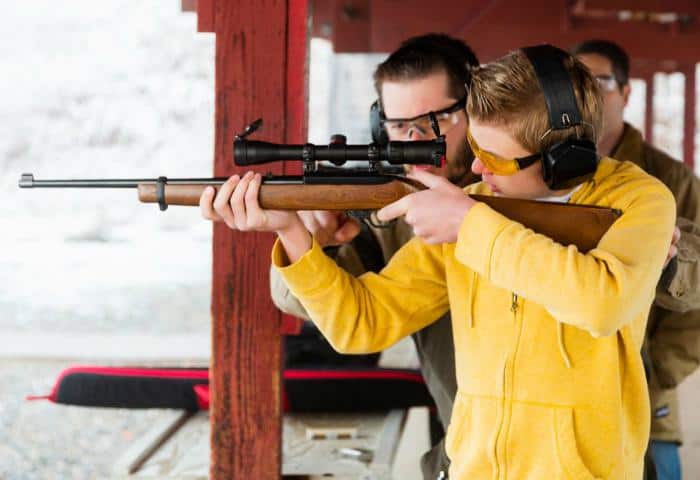
How is Rifle Recoil Calculated?
There are two terms to be familiar with when discussing rifle recoil:
- Recoil velocity
- Recoil energy
Let’s get a little deeper into both:
Recoil Velocity
The recoil velocity is a numerical rating determining the velocity (or speed) of the recoiling item as it travels backward. This figure is measured in feet per second (FPS) and uses a somewhat complicated formula using data like bullet weight, muzzle velocity, rifle weight, etc.
Recoil Energy
The recoil energy of a firearm (which may also be listed as the free recoil energy) is a complicated formula that considers factors like recoil velocity, rifle weight, the weight of the bullet, speed of the bullet, etc.
I’m no math wizard, so I won’t even try to reprint the exact formulas here because gun people who are much more mathematically inclined have already done so and have a much better job than I ever could.
All the recoil data that I’ve used below comes from the following two websites with excellent rifle recoil tables, and I’ve included links to both:
Backfire.tv – Rifle Recoil Table
Backfire.tv – Shotgun Recoil Table
Chuck Hawkes – Rifle Recoil Table
Both of these sites have a wealth of information on recoil in general and are worth a visit.
Something else to be aware of when evaluating data with recoil numbers: Rifle weight, bullet weight, and muzzle velocity play a significant role in the recoil force calculation. To normalize the data, averages were used in the calculations for each caliber.
I say this to point out that the recoil numbers I used below are more like estimates versus hard data due to the sheer number of variances in rifle weight, bullet weight, etc.
Factors that Play a Role in Recoil
In addition to the recoil differences between calibers, some other factors affect the recoil, including:
Rifle Weight
I briefly touched on this above, but the rifle’s weight can significantly affect the overall recoil and felt recoil. The heavier the rifle, the less the recoil because the weight helps slow down the recoil speed.
I can promise you that there’s a serious difference in felt recoil between a ten lb. rifle chambered in .300 Winchester Magnum and a 25-pound dedicated bench rifle chambered in .300 Win. Mag. In that scenario, the weight makes that rifle go from borderline unpleasant to surprisingly tame.
Here’s a real-life example of how weight matters:
I’ve been researching “mountain guns” over the last few months as I’m looking for a lightweight rifle to take on an upcoming hunt for mule deer in Colorado. I decided on a Howa Super Lite rifle in .308. I opted for .308 because It’s versatile enough to be used for other big game as well.
With rings and a scope, that Super Lite weighs just over 6 ½ lbs. (6 lbs. 10 ounces to be exact). Now, I’ve shot many .308 rifles in my life, so I’ve got a decent amount of experience with the caliber. Based on my experiences, I would classify the .308 as having a “moderate” recoil.
However, that Super Lite rifle is, without a doubt, the hardest kicking .308 I’ve ever shot. Now, I probably won’t notice if I pull the trigger on a Muley, but I certainly noticed it when sighting in the scope. I definitely would not classify the recoil on that new Howa rifle as “moderate.” Now, I kind of wish I had gone with the 7mm-08 version versus the .308 for such a light rifle.
Recoil Velocity
I touched on recoil velocity above, but it also plays a role in the recoil, especially in conjunction with the rifle weight.
The faster the recoil velocity, the more of an abrupt, high-speed rearward movement. Rifle calibers with a slower recoil velocity tend to create more of a rearward “push,” while the calibers with a higher recoil speed are more likely to generate a more abrupt and aggressive backward action.
More Potent Ammunition
Some types of ammunition have a higher amount of powder for added velocity or for driving a larger size bullet at a faster velocity. This type of ammunition may cause an increase in the recoil when compared to ammo with less powder, but the amount is generally minimal.

Potential Issues with Recoil and Kids
I briefly touched on a few of these potential issues above, but with rifles, there are two unpleasant aspects that have to be addressed with kids:
- Recoil
- Sound of a gun going off
These two aspects of firing a rifle seem to cause kids and teenagers the most significant volume of stress with deer hunting.
Here are a few more potential issues with recoil for kids:
Perceived Excessive Recoil Can Lead to a Bad Experience
As mentioned previously, when I shared my first adverse recoil story, perceived excessive or heavy recoil for kids or teens can lead to a bad or poor experience in the field. In addition, if this is their first deer hunting experience, a bad experience may very well be their last deer hunt.
While most kids don’t seem to notice the recoil as much when shooting at a live target, they really seem to notice it on the practice range.
Can Create an Anticipation Flinch that Impacts Accuracy
In addition to a poor shooting experience, young and new shooters may also develop an anticipation flinch that arises from recoil.
With an anticipation flinch, the shooter anticipates the recoil, so they flinch right as the trigger is pulled to prepare for it. Something else I’ve noticed with younger shooters is that they may also develop a noise-related flinch, even with the use of hearing protection. In those situations, the shooter flinches as the trigger is pulled because the rifle report is perceived as loud or frightening.
Can Lead to Injury Through Scope Impact
Hopefully, this doesn’t occur, but young shooters seem prone to having the rifle scope or optic impact their face while shooting. In some cases, these are just minor situations where the optic barely touches the face, and then some are more serious where the optic makes contact with the face or head and causes an injury.
I’ll get more into rifle scopes for young deer hunters later in this post, but most of these scope impact situations occur when the child or youth is shooting a rifle set up by an adult, so the scope eye relief is set for an adult.
When the scope eye is not correctly set for the child, they try to adapt by getting their eye as close as possible to the scope. Unfortunately, this can lead to injury or an extremely unpleasant experience when the rifle is fired.
Young shooters typically struggle to see clearly through scopes in general, so red dot optics may not be a bad choice.
How Much Recoil is Too Much for Kids?
That’s a challenging question to answer because the perception of recoil varies so much from individual to individual. I’ve had experience with kids who shot their dad’s .270 Winchester with no issues, and then I’ve seen other situations where a 13-year-old complained about the recoil of a .223 from a modern sporting rifle.
My rule of thumb is to keep the recoil under 15 ft-lbs. for kids, although I prefer something closer to the 12 ft-lbs., especially for younger children in the seven to the ten-year-old range. With kids that have little to no rifle shooting experience, I would definitely suggest keeping the recoil number under 12 ft-lbs.
Remember that these are just my personal preferences, as my goal has always been to ensure that the youth or child enjoys the experience.
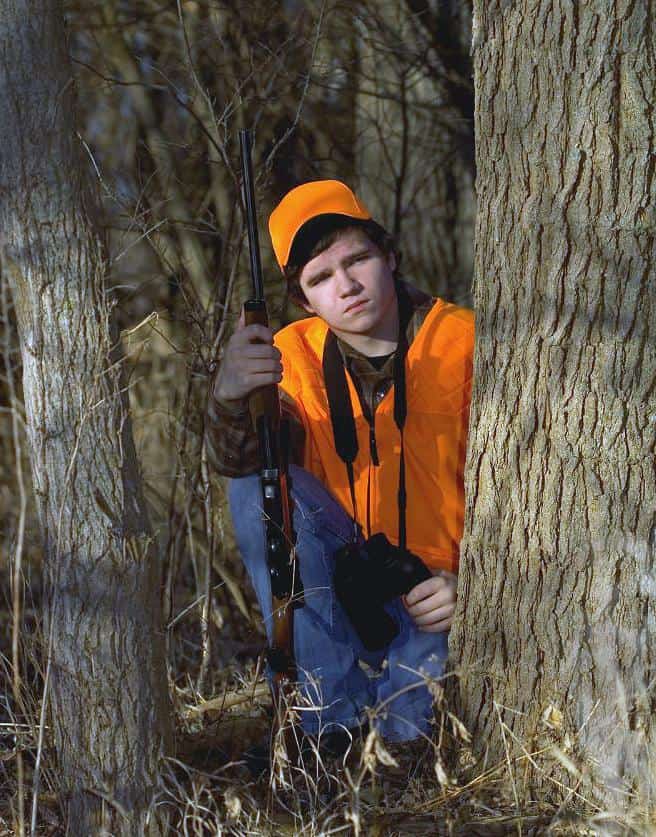
8 Best Kid-Friendly Deer Rifle Calibers with Lower Recoil
I put this list of my top 8 deer rifle calibers for kids together based on the following criteria:
- The measured amount of recoil, according to up-to-date data
- The caliber’s terminal ballistics for deer-sized game.
- The availability of commercial ammunition created specifically for deer.
These calibers are listed in order from the lightest recoiling to the heaviest recoiling.
Let’s take an in-depth look at each caliber selection.
Top 8 Youth Deer Rifle Calibers with Lowest Recoil | ||
Caliber | Average Recoil (in ft-lbs) | Average Energy Delivered at 100 Yards |
.300 AAC Blackout | 5.45 ft-lbs. | 990 - 1050 ft-lbs |
.223/5.56 NATO | 5.48 ft-lbs | 900 - 1200 ft-lbs |
6.5 Grendel | 6.18 ft-lbs | 1500 - 1700 ft-lbs |
.350 Legend | 7.08 ft-lbs | 1250 - 1350 ft-lbs |
7.62x39mm | 7.11 ft-lbs | 1100 - 1200 ft-lbs |
.243 Winchester | 9.22 ft-lbs | 1500 - 1700 ft-lbs |
30-30 Winchester | 9.97 ft-lbs | 1000 - 1900 ft-lbs (depending on ammo) |
6.5 Creedmoor | 11.87 ft-lbs | 2000 - 2150 ft-lbs |
.300 AAC Blackout
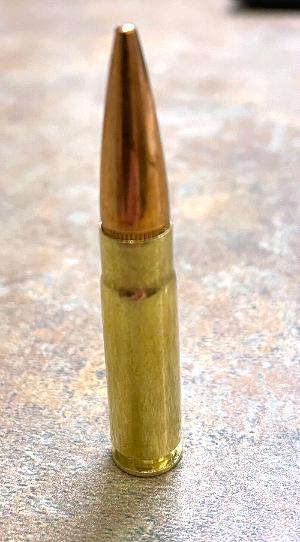
Introduced by Advanced Armament Corporation in 2019, the .300 AAC Blackout was originally designed for military use as a close-quarter suppressed caliber for the AR-15 platform. The standard 5.56/.223 caliber doesn’t suppress all that well, as the caliber is not subsonic by nature. However, the .300 AAC Blackout (which is also commonly called the 300 Blackout) suppresses very well out of the AR-15 platform.
While the .300 AAC didn’t really catch on as well as hoped in the military market, it did develop a following in the civilian market, especially for those looking for a legitimately suppressed caliber from an AR platform.
In addition to being offered in the AR platform, several firearms makers now offer the .300 Blackout in a bolt rifle configuration. Gun brands such as Ruger, Remington, Savage, and Christiansen Arms offer bolt action rifles with shorter barrels and threaded barrels chambered in the .300 AAC caliber.
.300 Blackout Bullet Options
Optimally, you’ll want a hunting bullet that expands on impact, so I suggest sticking with bullets in the 110-grain to 150-grain range. Many hunters are tempted to go with the larger 220-grain bullet, thinking that larger is better. Unfortunately, the 220-grain bullet is moving so slowly that it doesn’t usually expand properly on impact with deer. It’s far more likely to travel through without expanding, which isn’t very effective for an ethical, one-shot kill.
Luckily, there are several effective bullet options on the market in .300 Blackout made specifically for use on deer.
Shot Placement is Critical
To be clear, shot placement is always critical, but more so with the Blackout because of the reduced power of this caliber.
Since the 300 Blackout is on the lower end of acceptable kinetic energy to harvest a whitetail, there’s less room for error regarding shot placement. A poor shot on a deer with this cartridge will likely result in a long tracking session and can mean an unrecoverable deer. In all honestly, I’ve had a few situations with young kids where a doe shot poorly with a .300 AAC was never recovered.
However, in my experience with the .300 Blackout, most deer shot with an appropriate bullet, and a well-placed shot rarely makes it over 50 yards. In addition, the recoil on this caliber is so low that most kids have little problem being accurate.
Barrel Length Matters
Given the terminal power of the .300 AAC cartridge, a longer barrel length on the rifle will help with increased velocity. I’d suggest staying with a barrel length in the 16.5″ to 20″ range, as those lengths offer a good balance between weight, increased bullet velocity, and maneuverability.
On some of the father/son and father/daughter hunts I’ve participated in, I’ve had fathers who brought an AR pistol in 300 Blackout for their children to use. However, I don’t recommend this approach because the shorter barrels (especially in the 6,7, and 8-inch range) can cause a significant reduction in velocity over an 18-inch barrel.
.300 Rifle Options
Although the Blackout was created for use in an AR-15, I find that the bolt action models or the single-shot rifles are the best options for children and younger hunters. I’m especially fond of the single-shot, break-open style rifles as they are simple to operate, lightweight, and more than accurate enough for deer in the 50 to 75-yard range.
While the single shot action loses the capability of a quick follow-up shot, most kids will not get off an accurate follow-up show on a deer on the move anyway. Plus, the simplistic operation helps with shooter safety.
300 Blackout Recoil
With a recoil rated at 5.45 ft-lbs., even the most lightweight AAC rifle features an extremely mild kick. For a comparison perspective, a 22LR has a recoil rating of .12, so the .300 AAC is slightly over five times the recoil of a .22LR.
The downside of the 300 Blackout is its reduced terminal velocity, which is usually somewhere between 500 and 1400 foot-pounds of energy at impact at 100 yards, depending on the bullet grain.
Given those ballistics, the Blackout is really only effective on deer at a maximum range of 100 yards, and I prefer to keep youth shots more in the 75 yards or less range.
300 Blackout Downsides
While the 300 AAC is a viable deer cartridge, it does have some downsides, including the following:
I’ve already touched on this topic earlier, but it’s worth mentioning again. With its reduced kinetic energy delivery at distances, the Blackout is a short-range caliber that is most effective in the 50 to 75-yard range. I’d suggest being careful about any shot for a youngster over 100 yards with the AAC because the odds of a wounded deer start to increase at that distance.
Another potential downside to the Blackout is the cost of ammunition. While the 300 isn’t the most expensive caliber to shoot on this list, it’s not exactly budget-friendly either.
My last downside with the AAC is its limited versatility. It can be used in a short-range scenario on other game species like coyotes, varmints, and feral pigs. However, the AAC lacks enough power to use on any game species larger than deer.
Final Thoughts on the 300 Blackout
Although the Blackout has the lowest recoil of any cartridge on this list, it comes with the trade-off of a lower-powered caliber that is right on the edge of having sufficient terminal velocity to ethically harvest a whitetail.
However, if you have a child or youngster that is very sensitive to recoil, then the 300 AAC could make for a good youth hunting rifle.
.223/5.56
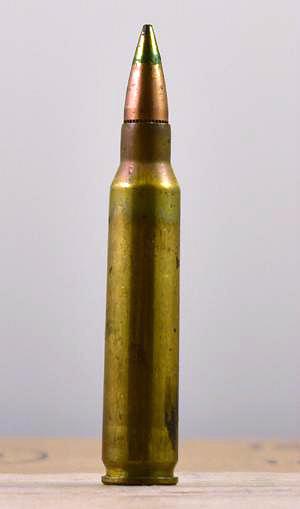
Next up on my list are the Remington .223 and NATO 5.56 calibers. To be clear, I’m not a huge fan of the .223/5.56 for deer under most circumstances due to the smaller bullet sizes and the lower kinetic energy at distances over 100 yards. However, with the right bullet and solid shot placement, these calibers are an acceptable deer round.
Something else to mention on these calibers: some states have minimum caliber restrictions prohibiting the use of any .22 caliber-based cartridges. In that case, the .223 wouldn’t be legal for use in those states. So before you consider this caliber for deer, I suggest checking the caliber restrictions or caliber laws in your state.
Although the .223 Remington and the 5.56 NATO are different calibers, they are nearly interchangeable. Because of this similarity, I’m lumping them into one topic, with each caliber being the feature of a sub-topic. Any rifle chambered in 5.56 NATO will also shoot .223 Remington, but you have to be more careful going the other way because a rifle chambered in .223 Remington may not be able to withstand the higher pressure of the 5.56 rounds over an extended period.
.223 Remington
The .223 Remington was introduced in 1957 as a joint venture between Remington Arms and Fairchild Industries. This caliber was submitted to the U.S. military as part of a project to create a small arms, high-velocity caliber to replace the .30 caliber and 30-06 caliber. The U.S. military would end up adopting this caliber as their standard rifle caliber in 1963, and it was the standard chambering for the M-16 (the military version of the AR-15).
.223 Bullet Options
The 223 Remington cartridge is available in bullet options ranging from 35 grains up to 85 grains. The most popular bullet is the 55-grain version, followed by the 60-grain and 62-grain options. In addition, there are several ammo manufacturers who offer a .223 round manufactured specifically for deer hunting. Any hunter who uses a 223 for deer has their own opinion about the best ammo, but my favorites are these:
- Federal Premium 60 grain Nosler Partition
- Federal Premium 62 grain Trophy Bonded Tipped
- Winchester Deer Season XP 64 grain
223 Remington Rifle Options
Currently, the .223 is one of the most popular rifle calibers in the U.S. and is offered in several rifle configurations, including:
- AR-15 platform (although the primary caliber for modern-day ARs is 5.56)
- Semi-automatic
- Bolt Action
- Single Shot
5.56 NATO
The 5.56 NATO (which is also written as 5.56x45mm NATO) was originally created by FN Herstal in the late 1970s and was based on the .223 Remington. This caliber was adopted by NATO (the North Atlantic Treaty Organization) as the primary rifle caliber for all NATO members in 1980. When the 5.56 was adopted by NATO, the U.S. military shifted from chambering their rifles in .223 over to the NATO-based 5.56.
5.56 Bullet Options
From an ammunition perspective, most all the deer hunting ammunition on the market for the 5.56 is marked and marketed as being made for the “.223/5.56”. I’ve yet to see a dedicated deer hunting round that is marked as being specifically built for the 5.56. There are far more deer hunting ammunition options geared towards the .223 or geared to work for the .223 and 5.56.
5.56 NATO Rifle Options
Unlike the .223, which is chambered in several different rifle styles, the 5.56 is primarily available in the AR-15 platform. I’ve yet to see a bolt or hunting-based semi-automatic rifle specifically chambered in 5.56.
.223/5.56 Recoil
Now that I’ve briefly covered both cartridges, let’s discuss the .223/5.56 in terms of deer hunting recoil. From a recoil standpoint, the 223/5.56 calibers average 5.48 ft.-lbs. of recoil, which is relatively low. In addition, if using an AR-15 with an adjustable gas block, you may be able to get the recoil numbers even lower.
As I previously mentioned, I’m not a big fan of using a .223 for deer hunting because it has marginal terminal velocity for deer-sized game. However, with the right bullet and within shorter distances, the .223 can be a good deer caliber for a child or youth.
In addition to the lower recoil, the .223 has some other factors going for it when it comes to deer hunting:
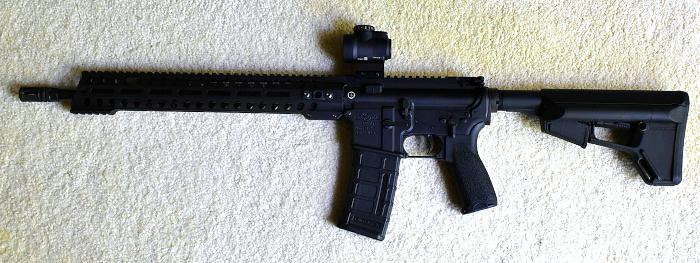
AR-15 Popularity
The AR-15 is the most popular rifle platform on the market today, so it’s entirely possible that you already own one your son or daughter can use. This potentially helps the bank account as you aren’t forced to buy another rifle for one of your children.
Wide Range of Deer Focused Ammunition
Given the popularity of the .223, several prominent ammo brands now offer a wide variety of 223 ammunition specifically geared toward deer hunting. The availability of deer hunting ammo is a plus for the .223.
The .223 is Deer Accurate
Regardless of the rifle platform or type, almost any .223 rifle is capable of the necessary accuracy to hit a whitetail’s vitals.
223/5.56 Downsides
While the 223/5.56 can harvest deer, it’s not perfect. Here are a few things to know when using this caliber for deer.
If you opt to use a .223 for deer, I’d suggest doing the following:
Keep the shots at 75 yards or less.
Although the 223 can shoot much farther, I’ve had the best results on deer when the distances to target are 75 yards or less. In addition, the closer the deer target, the easier for a child or teenager to make a well-placed shot.
Spend the money on a good quality deer hunting bullet for the .223.
I’d expect to spend at least $2.00 a round. I’d also resist the urge to use a standard 5.56 or 223 FMJ (Full Metal Jacket) bullet in 55 grains because you already have some on hand. While this standard cartridge configuration is the most common and plentiful ammunition for the 223/5.56, it’s not the best deer bullet.
While this round can and does harvest thousands of deer annually, the bullet ballistics are not ideal for whitetails. The 55-grain FMJ bullet doesn’t expand and typically penetrates entirely through a deer (unless it impacts bone). In addition, it makes a smallish entry hole, a smallish wound channel, and a small exit wound. All these factors, coupled with the reduced kinetic energy on impact, lead to a higher percentage of wounded and unrecovered deer.
Stay away from AR-15 Pistols
Like the .300 Blackout cartridge, I’d suggest avoiding using a 223/5.56 in an AR15-based pistol as the shorter pistol barrels significantly reduce the muzzle velocity and can impact the accuracy at longer distances.

223/5.56 Final Thoughts
I prefer to use a .223 in situations with young children (in the 7-10 age range) or those with recoil anxiety. My go-to .223 for kids is a Howa bolt action model built on the Howa 1500 Mini-Action with a heavy barrel. While the rifle is on the heavy side for a youth (11 pounds with optic), the added weight helps negate the recoil. In addition, when properly anchored, the weight keeps the rifle in place as the kids are shooting.
6.5 Grendel
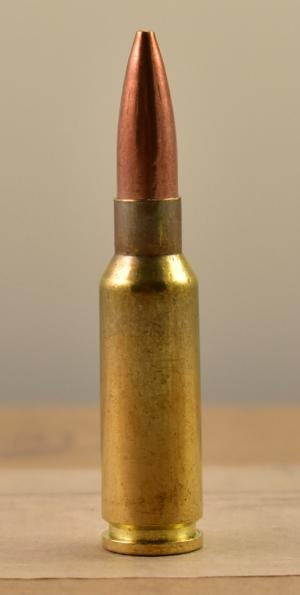
The 6.5 Grendel has quickly become one of my favorite deer calibers for kids because it has very minimal recoil and packs enough punch (kinetic energy) to handle deer-sized game very well. The recoil is only slightly more than a .223, but the terminal energy delivered downrange is much better than the 5.56/223.
The 6.5 Grendel was developed as a joint project between firearms maker Bill Alexander (who founded Alexander Arms), Arne Brennan, and Janne Pohjoispaa (a ballistician with Lapua ammo). Introduced in 2003, the 6.5 Grendel was designed as low recoil, mid-range AR-15-based cartridge with ballistics superior to the 5.56/223.
To be clear and avoid any confusion, the 6.5 Grendel and the 6.5 Creedmoor are different calibers, and I’ll be discussing the 6.5 Creedmoor in more depth below.
6.5 Grendel Bullet Options
Factory bullet configurations for the Grendel range from 90-grains up to 130-grains with muzzle velocities ranging from 2500 to 2900 feet per second. Several Grendel loads can deliver 1000 to 1100 foot-pounds of energy out to the 300 to 400-yard mark and kinetic energy of 1500 to 1700 foot-pounds of energy at 100 yards. However, beyond 400 yards, the energy levels begin to drop rapidly.
As the 6.5 Grendel has increased in popularity, several name-brand ammunition makers have introduced 6.5 GR ammo that works well on deer.
My favorites are:
- Hornady Custom 6.5 Grendel 123 grain SST (Expensive, but my current favorite for deer)
- Federal Fusion MSR 6.5 Grendel 120 grain (an excellent choice if you’re using an AR-15 or MSR)
- Nosler Trophy Grade 6.5 Grendel 129 grain Accubond
6.5 Grendel Rifle Options
Although the Grendel was introduced for use in an AR-15, gun manufacturers now offer the caliber in bolt action rifles and single-shot options.
The AR-15 (which you may also see listed as a Modern Sporting Rifle) can decrease the recoil even more, but not all the Grendel loads for deer perform well in a shorter-barrel AR15.
My go-to 6.5 Grendel for kids is a Howa Mini-Action bolt action model with a threaded barrel. I also use a suppressor to reduce the sound and recoil even further with kids.
6.5 Grendel Recoil
The Grendel generates approximately 6.18 foot-pounds of rearward force. For comparison, the average .243 Winchester generates 9.22 foot-pounds of recoil, and the average 12 gauge shotgun generates 18 foot-pounds of recoil with a target load.
Based on those numbers, you can see that the Grendel is a very low recoil option for deer hunting.
6.5 Grendel Downsides
Although I have very few complaints about the Grendel, there are a few areas worth discussing:
If I had a major complaint about the Grendel, it would be that the ammunition is only available in a small range of grain weights, so there aren’t near the number of ammunition options available compared to a more popular round like the 6.5 Creedmoor. As such, there may only be one or two potential ammo options on the shelf at your local gun store.
The Grendel performs well on deer-sized animals and feral pigs but isn’t the best option for any game species larger than deer. If you’re looking for a caliber that a youth can grow into and use for larger game like elk, then there are probably better calibers for that specific situation.

Final Thoughts
The Grendel is definitely one to consider if you’re in the market for a new deer caliber for your son or daughter, and recoil is a concern. It’s more than adequate for deer out to ranges of 100 to 200 yards, assuming the youth can make an accurate shot at that distance.
Given a choice between having a young person use a .223 or 6.5 Grendel for deer, I almost always go with the Grendel, unless the child or parent has major concerns about recoil.
.350 Legend
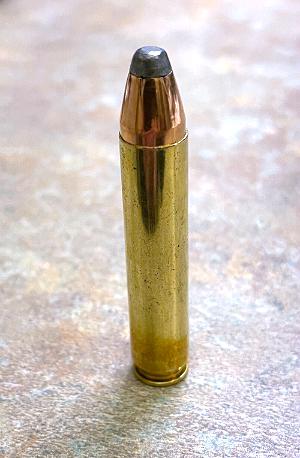
The .350 Legend has an interesting backstory, as it was developed solely to fit a specific need within the hunting community. Introduced by Winchester in 2019, the 350 Legend is a straight-wall cartridge (as in no neck or angles in the case) made for deer hunting in states that only allow straight-walled calibers. Examples of states that only allow straight-wall cartridges include:
- Iowa
- Indiana (Public Land)
- Ohio
While the Legend isn’t the only straight-walled caliber on the market, it is one of the softest recoiling calibers capable of ethically harvesting whitetail deer and mule deer at distances of 200 yards or less.
350 Legend Bullet Options
Commercially available ammunition for the Legend ranges comes in a wide variety of bullet grains, ranging from 145 grains on the low end up to 250 grains. Several ammunition manufacturers offer an FMJ bullet for the .350 Legend, and those are typically 145 grains.
Since the 350 Legend was developed explicitly for deer hunting, there are many excellent deer hunting rounds in this caliber on the market. A few that I like include:
- Winchester Power-Point .350 Legend 180 Grain
- Winchester PowerMax .350 Legend 160 Grain
- Hornady American Whitetail .350 Legend 170 Grain SP
I would not recommend using the standard FMJ Legend bullet for deer because the FMJs don’t expand and leave a narrow wound track.
Although the Legend was designed as a deer cartridge, hunters have also found success using the caliber on black bears, mule deer, and feral pigs at ranges under 200 yards.
.350 Legend Rifle Options
When Winchester first introduced the Legend cartridge, they only chambered it in bolt action rifles. Today, the 3650 Legend is available in:
- The AR15 platform
- Bolt action rifle
- Single Shot models
While I like the AR-15 platform, my preferred 350 Legend rifle to use for kids and teens is a bolt action model. My personal favorite is a Ruger American Ranch rifle with a threaded barrel. That model is relatively compact and light enough for most kids to maneuver easily. Plus, the threaded barrel also allows for use with a suppressor.

350 Legend Recoil
The .350 Legend has an average recoil of 7.08 ft-lbs., which is still quite manageable for most kids. For comparison purposes against other straight-walled calibers, the 44 Magnum (in a rifle) exerts an average of 11.2 ft-lbs. of recoil, while a .450 Bushmaster exerts 22.22 ft-lbs. of recoil, on average.
In addition, to having a mild recoil in general, the 350 Legend is the mildest recoiling, commercially available, straight wall cartridge on the market today.
Final Thoughts
Whether you reside in a state with straight wall caliber restrictions or not, the .350 Legend delivers a substantial amount of kinetic energy on target compared to the mild recoil.
The Legend is an excellent first deer rifle caliber for a young deer hunter and is also versatile enough to be used on some larger game at short distances. I’ve found the .350 Legend to be an excellent performer for deer with a high animal recovery rate (in conjunction with an accurate shot).
7.62 x 39mm

Another potential caliber that is recoil friendly for deer is the classic 7.62×39. While this caliber was designed in Russia and is best known for use in combat rifles like the AK-47 and SKS, it is pretty effective on short-range deer with the proper ammunition.
The caliber ballistics are very similar to the ever-popular 30-30 caliber, although the 7.62 has slightly less kinetic energy at 100 yards.
The 7.62x39mm was developed in Russia in 1944 as a caliber upgrade for the Russian military after World War II. This caliber is now the most widely used military caliber in non-NATO countries.
7.62×39 Bullet Options
Given the longevity and popularity of the 7.62×39, tons of ammunition options are available on the market. However, most of that ammo is steel case stuff in a full metal jacket (FMJ) geared toward range use or plinking. I don’t recommend any of the FMJ rounds for hunting because they don’t offer any bullet expansion.
Commercially manufactured 7.62x39mm ammunition comes in bullet grain sizes ranging from 120 grains up to 250-ish grains. However, the most popular bullet grain for hunting is around 123 grains.
Several well known ammunition makers offer deer hunting rounds in 7.62×39, including Remington, Winchester, Hornady, and Federal.
Some of my favorite 7.62 rounds for deer hunting are:
- Winchester Deer Season XP 7.62×39 123 Grain
- Federal Fusion 123 Grain FSP
7.62X39mm Rifle Options
Initially, the 7.62×39 caliber was only available in semi-automatic rifle platforms like the AK-47 and SKS. Over the years, gun makers have expanded the rifle options for this caliber to include the following:
- Hunting based semi-automatics
- Bolt Action rifles
- Single Shot options

7.62×39 Recoil
The 7.62 x 39mm cartridge generates 7.11 foot-pounds of recoil, which is very light. For comparison purposes, a 20 gauge shotgun with target loads generates 11 foot-pounds of recoil, while a .270 Winchester generates 17+ foot-pounds of energy in recoil.
Most kids and teens have no problem accurately shooting a 7.62×39 caliber.
7.62 Downsides
Like any cartridge, the 7.62x39mm has some limitations and potential downsides, including the following:
While the 7.72×39 delivers a little over 1000 foot-pounds of kinetic energy at 100 yards, it’s a short-range deer caliber. And the 1000 foot-pounds of kinetic energy is really the very bottom of the generally accepted, necessary amount of kinetic force to harvest whitetail deer ethically.
In general, 7.62×39 bullets have a low ballistic coefficient, so once the bullet moves past 100 yards, it rapidly drops in power. At 300 yards, the 7.62×39 is down to around 875 foot-pounds of kinetic energy on impact.
The other potential downside is the availability of deer-specific 7.62×39 ammunition outside of a gun store. By that, I mean that the chances of finding some 7.62×39 ammo designed for deer hunting at your local Wal-Mart or a small sporting goods store are probably low. You’ll likely find 7.62×39 ammo in those locations, but they will be general range-based ammo versus ammo explicitly made for deer hunting.
Final Thoughts
The 7.62×39 is certainly a viable deer caliber under the following two conditions:
- The shooting distances are kept to under 100 yards.
- Specific deer hunting ammo for the 7.62×39 is used.
As long as those two guidelines are followed, this caliber is a very effective option for harvesting a child’s first deer.
.243 Winchester

If you’ve been researching recoil-friendly deer calibers, I doubt you’ve come across any articles or posts that did not include the popular .243 Winchester as an option.
While the recoil is more than any of the other calibers discussed so far, the .243 is among the most popular calibers for younger hunters. Several prominent hunting magazines routinely rate the .243 among the top five best deer hunting cartridges of all time.
There are several reasons for that popularity, including:
- The softer recoil compared to calibers with similar ballistics.
- The wide availability of deer hunting ammunition for the caliber.
- The wide range of rifle options for .243.
- The cartridge’s capability to ethically harvest medium and large game species.
The .243 Winchester (which is sometimes listed as the Winchester .243 or 243 Win) was introduced in 1955 as an alternative to the .308 with similar ballistics and less recoil. In fact, the .243 is actually built on a necked-down .308 cartridge.
Once introduced, U.S. hunters quickly adopted the 243 as it had smaller bullet configurations and rounds that were ideal for varmint hunters. And, with larger bullet options, it was highly successful on deer and other big game species. The .243 is also used by young hunters to harvest larger species like Elk and Black Bear (with the right ammo). Although to be honest, I think there are better calibers on the market for elk.
.234 Winchester Bullet Options
Given the overall popularity, it’s no surprise that there are a wide variety of bullet options for the 243. With commercially loaded ammunition, the bullet sizes range from 55 grains to 125 grains. Since the 243 has also gained a following among varmint and coyote hunters, the smaller grain bullets in the 55 to 75-grain ranges are best suited for use on predators. However, for larger game species like whitetail deer, mule deer, and black bear, I’d stick with bullets that are at least 100 grains and designed for use on game animals.
Since the 243 has gained such a following among deer hunters, many commercially available deer hunting rounds are on the market in this caliber.
While there are several that I really like, these are my favorites:
- Hornady makes several good ammo options for the .243, but I like the American Whitetail with 100 grains IL. However, Hornaday is one of the few ammo brands that makes a reduced recoil hunting load specifically for the 243, and it’s absolutely ideal for young shooters. This ammo is called the Hornady CustomLite Reduced Recoil 87-grain SST. Although the bullet weight is under 100 grains, it’s still an extremely effective deer caliber for shots under 200 yards.
- Winchester Deer Season XP 95 Grain Extreme Point
- Federal Premium 100 grain Nosler Partition
.243 Winchester Rifle Options
While the .243 was originally only chambered in bolt action rifles, gun manufacturers have responded to the caliber’s popularity by chambering other rifle styles in the caliber. These days, the .243 is offered in:
- Lever Action
- Bolt Action
- Semi-auto (Hunting based)
- AR-10 Platform
- Single Shot
- Rifle/shotgun Combination Guns (like the Savage 24)
Although I’ve owned several different 243 rifles throughout my life, I’m still partial to bolt action models. My first 243 was an older Ruger M77 that I still have. My go-to 243 for kids/youths is a Ruger American Go Wild model with a threaded barrel. While the Go Wild isn’t the lightest bolt action 243 on the market, the marginal added weight helps reduce the recoil just a little bit.
There are also several firearms makers who offer a youth rifle or youth model chambered in 243, so those could be an option as well.
243 Winchester Recoil
The .243 has an average recoil of 9.22 foot-pounds, which is still very mild for a caliber that delivers between 1500 and 1800 foot-pounds of kinetic energy at 100 yards (depending on the load).
For comparison purposes, a 12 gauge shotgun running standard 00-buckshot generates a typical recoil of 17.3 ft-lbs., while a 308 Winchester rifle generates a recoil of 18.27 ft-lbs, on average. So, a 243 has nearly half the recoil of a 12 gauge and 308.
.243 Winchester Downsides
Honestly, in my humble opinion, the 243 is one of those calibers that doesn’t really have any downsides. First, the ammo for the caliber is plentiful, and every gun store will likely have some on hand. Second, there are many rifle options and configurations in 243 on the market in a wide range of price points.
With the proper ammunition, the cartridge is capable of ethically harvesting game species, including:
- Predators (ammo makers even offer commercial ammunition geared towards varmint or predator hunting)
- Wild Pigs
- Whitetail Deer
- Mule Deer
- Black Bears
- Elk (although this may not be an ideal caliber for elk, it is used for elk)
If I had to identify a potential downside, it’s the fact that this caliber generates about two more foot-pounds of recoil compared to all the other calibers that I’ve discussed so far.
Final Thoughts
The 243 may be the most popular deer cartridge on this list used for youth deer hunting. In all my years of taking kids hunting or participating in kids hunting programs, I’ve seen more 243 rifles used in that capacity than any other caliber.
It’s undoubtedly one of the most versatile calibers on this list and ranks up there with a 6.5 Grendel as one of my all-time favorite calibers for young deer hunters. While the Grendel doesn’t have quite the same terminal velocity as a 243, it also has less recoil.
It may be the ideal “do it all” caliber because it’s one that kids can use for years and continue using should they decide to go after other large game species.
30-30 Winchester

Out of all the calibers on this list, I have a feeling that the venerable 30-30 Winchester has been responsible for more harvested deer than most of the other calibers discussed. This statement is especially true in the southeastern United States.
I grew up in rural parts of central and southeastern North Carolina, and it seemed that every hunting household in that area had at least one 30-30 in the family. It was that time and region’s primary hunting cartridge (always in lever action). The 30-30 was also my first deer rifle and the caliber I used to take my first deer (and several others as well).
The 30-30 Winchester is also the oldest cartridge on this list, as it was introduced in 1895 for the Winchester Model 1894 lever action. Although the official caliber name is .30-30 Winchester, this cartridge is also commonly called or written as:
- 30-30
- 30/30
- Winchester 30-30
Most shooters simply refer to the caliber as “30-30”.
30-30 Bullet Options
Discussions about 30-30 bullets really should be broken down into the following categories:
Traditional 30-30 Ammunition
The 30-30 is most commonly chambered in lever-action rifles with a tubular magazine so the rounds are stacked up one behind another. So that a sharply pointed bullet wouldn’t set off or detonate the primer on the round in front of it during the recoil, most traditional 30-30 ammunition is manufactured with a round nose or flat-tipped bullets.
Traditional 30-30 ammo utilizes bullet sizes ranging from 110 grains up to 170 grains, delivering anywhere from 1100 to 1300 ft-lbs. of kinetic energy at 100 yards. If you subscribe to the theory that a caliber needs to deliver at least 1000 ft-lbs. of energy to effectively kill a whitetail, then venerable 30-30 loaded with traditional ammunition barely makes the minimum. Part of the issue is the round or flat-nose bullets, which have an extremely low ballistic coefficient and start losing power just after the hundred-yard mark.
For comparison purposes and to illustrate just how much power is lost, most traditional 30-30 ammunition drops to less than 1000 ft-lbs. of energy just after the 100-yard mark and before hitting the 150-yard mark.
These numbers make a 30-30 loaded with traditional ammo, a short-range deer rifle for targets 100 yards or less.
Modern 30-30 Ammunition
In 2011, Hornady Ammunition introduced a new type of ammunition made specifically for lever action rifles. This ammo line was called LEVERevolution, and it featured a flex-tipped spiral-shaped bullet that could safely be loaded into the tubular magazine of most 30-30 rifles without the usual concerns of accidental detonation.
In addition to the new bullet form, these modern bullets were manufactured from a denser copper alloy than traditional lead. As a result, these modern bullet upgrades, including an upgrade in powder, also meant a substantial upgrade in performance.
The LEVERevolution rounds now deliver 1900 ft-lbs. of energy at 100 yards, 1300 ft-lbs. at 200 yards and just over 1000 ft-lbs. at 300 yards. These rounds now have enough energy and ballistic performance to harvest a whitetail at 300 yards potentially.
The success of the LEVERevolution ammunition led other ammunition brands to introduce similarly-style rubber-tipped 30-30 rounds for lever action rifles.
If you plan on using a 30-30 as a child or teenager deer rifle, I suggest going with the more modern LEVERevolution-style rounds as they have more power with no additional recoil and make the 30-30 even more effective on deer.
30-30 Rifle Options
Even though the 30/30 caliber was introduced in a lever action rifle over 100 years ago, the lever action design is still the most popular rifle format for the .30-30 caliber.
Over the years, a few manufacturers introduced a bolt action model chambered in 30-30, but it never caught on.
The lever action 30-30 market is dominated by Winchester and Marlin, although a few other brands, like Henry, also specialize in lever action firearms.
So, if you plan on having your nephew or grandson use 30-30 for his first deer, there’s a high probability that he will use a lever action rifle.

.30-30 Winchester Recoil
The average 30-30 rifle generates 9.97 ft-lbs. of recoil when fired, so the recoil rating is still under 10 ft-lbs. of force. In comparison, a 20 gauge shotgun shooting target loads delivers approximately 11 ft-lbs. of recoil, while a 30-06 Springfield rifle generates an average of 21.34 ft-lbs. of recoil.
30-30 Downsides
The 30/30 Winchester caliber only has a few potential downsides, in my opinion:
- The marginal amount of kinetic energy the older style 30-30 rounds deliver at 100 yards. That number is typically just over 1000 ft-lbs. at 100 yards, which is right on the border of having sufficient kinetic energy to harvest whitetail deer. That being said, thousands and thousands of deer have fallen to that caliber, so it obviously works.
- Using traditional ammo, the amount of kinetic energy delivered at 100 yards compared to the recoil value doesn’t make much sense when there are other calibers out there with less recoil and better kinetic energy. For example, a 243 has slightly less rated recoil than the 30-30 but delivers anywhere from 500 to 800 more ft-lbs. of energy at 100 yards.
Final Thoughts on the 30-30
Even though the ballistics on the 30-30 aren’t the greatest, it’s hard to argue with the results because the 30-30 just kills deer under 100 yards. However, I still find the ballistics a bit puzzling in light of its historical effectiveness.
If you’re going to let a child use a 30-30 rifle for deer, I would suggest the following:
- Use modern ammo that has better overall ballistic performance (with no increase in recoil)
- Keep the shots to targets under 100 yards.
6.5 Creedmoor
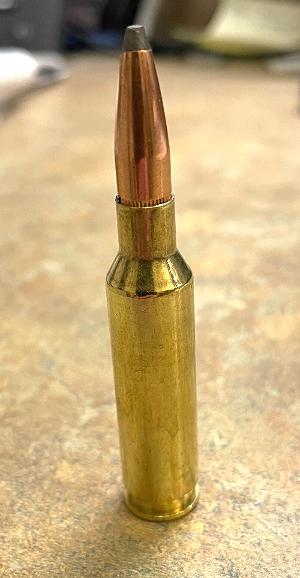
The final caliber on this list is the 6.5 Creedmoor, and this caliber has quickly gained a following amongst deer hunters thanks to its flat-shooting trajectory, terminal ballistics, and mild recoil.
You may also see the 6.5 Creedmoor caliber listed by the following names:
- 6.5 CM
- 6.5 CRDMR
- 6.5 Creed
- 6.5CR
The Creedmoor was developed in 2007 as a joint project between Hornady and Creedmoor Sports (Hence the “Creedmoor” designation in the caliber name). It was explicitly designed as a long-range target shooting round capable of accuracy out to 1200+ yards.
This Creedmoor caliber gained a major following in the long range community due to its flat shooting capability, low recoil, and long-distance accuracy. As a result, it may be the most popular caliber in long-distance shooting today.
The light recoil and downrange ballistics led hunters to start testing the Creedmoor on game animals. It quickly developed a following among hunters as a viable long-range caliber for deer-sized game species. Some hunters have even used the caliber to harvest larger species like elk and black bear.
6.5 Creedmoor Bullet Options
Given the popularity of the Creedmoor, there are several good-quality 6.5mm bullet options on the market made specifically for deer hunting. Creedmoor bullets come in several configurations, but the typical bullet sizes range from 90 grains on the lower end and top out in the 143 or 144-grain sizes.
Something to note with 6.5 Creed bullet options: since the Creedmoor is ultra popular as a long distance target caliber, there is a multitude of ammunition options on the market made for target shooting. That being said, I don’t recommend using the dedicated target rounds on deer (or most any other game) because those bullets are not built for penetration and expansion.
They are built for punching paper or pinging steel at a distance. I highly recommend using a dedicated 6.5CR hunting round for deer because those rounds are specifically made for use on game species.
The most popular grain size for deer hunting ranges from 120 grains up to 144 grains. I like the following 6.5 Creed ammo for deer hunting:
- Hornady Precision Hunter 6.5 Creedmoor 143 grain ELD-X
- Winchester Deer Season XP 6.5 Creedmoor 125 grain Extreme Point
- Remington Core-Lokt 6.5 Creedmoor 140-grain PSPCL (which is usually very reasonably priced)
6.5 Creedmoor Rifle Options
Given the following that the 6.5CR has developed, it’s not surprising that there are a plethora of rifle options on the market in that caliber. However, many are built for long-range shooting, so their weight rules them out as an option for kids unless you can set up some kind of bench or rifle rest while hunting.
From a sporting rifle standpoint, the two most popular styles for the Creedmoor are:
- Bolt Action
- AR-10 (Modern sporting rifle)
From a hunting perspective, the bolt action option is excellent for kids and young children due to its simplistic operation, safety features, and overall size/weight.
I have seen some fathers who brought out semi-automatic AR-style rifles chambered in 6.5CR for kids to use, and those work well too. However, that rifle style has more operational controls and can (in some cases) weigh more than a basic bolt action rifle.
I find the bolt action rifles in 6.5CR to be a better option for kids and teens because they are simple to operate, limited to one shot without operating the bolt, and easy to get on target. Plus, there are a few firearms brands that offer a youth gun version in the 6.5CR.
My go-to 6.5 CR rifle that I use with kids is a Browning X-Bolt with a suppressor. While this particular rifle is heavier than some other Creedmoor rifles I own, the weight helps soak up some of the recoil. I typically have kids shoot from a tripod rest to help compensate for the rifle weight.
6.5 Creedmoor Recoil
The average 6.5 Creedmoor rifle generates 11.87 ft-lbs. of recoil force when fired. This makes the Creedmoor the highest-rated recoiling caliber on this list. That being said, 11.87 is not all that much recoil for a child. As I stated before, I try to stay under 12 ft-lbs. of rifle recoil for kids, so the 6.5CR comes in just under that number.
How much recoil is 11.87 ft-lbs.? For comparison purposes, the average .410 shotgun loaded with clay target shotgun shells generates about 4.6 ft-lbs. of recoil, and the average 20-gauge shotgun loaded with clay target shells generates about 11 ft-lbs. of recoil. So, shooting the average 6.5 Creedmoor rifle produces a recoil similar to a 20-gauge shotgun.
6.5 Creedmoor Downsides
Although the 6.5CR is towards the top end of recoil for this list, it has very few downsides. Ammunition is plentiful and commonly available at most sporting or gun stores. The caliber generates excellent terminal ballistics on deer at 100 and 200 yards (and beyond, but most kids aren’t going to be shooting past 200 yards).
If I had to note one downside with the 6.5CR, it would be the cost of the ammunition. While Creedmoor ammo is not especially expensive, it’s also not cheap. And, the specialized deer hunting ammo for the Creedmoor is also not cheap.
Final Thoughts on the 6.5 Creedmoor
I like the Creedmoor as a youth-friendly caliber because it’s effective, but the recoil is on the higher side for my tastes with some kids, especially really young ones. For that reason, I tend to lean towards other calibers with younger children (especially in the 7-10-year-old range) and bring out the 6.5CR for kids that are 11 and up. Again, however, that’s just my personal preference.
Honorable Mentions
Choosing which calibers to place on this list was challenging because there are several other recoil-friendly calibers that I omitted for one reason or another. So here are a few calibers that didn’t make the list but deserve an honorable mention in a discussion about child-friendly deer hunting calibers.
.257 Roberts
If you’ve been researching kid-friendly deer hunting calibers, this may be the first time you’ve seen the .257 Roberts listed as an option. Although I like newer fast-moving calibers as much as the next hunter, there’s still something to be said for the old-school calibers that move slower but still pack a wallop.
To be honest, I really debated about including the 257 Rob in this list or listing it as an honorable mention due to its dwindling popularity. However, since ammo is only commercially available on a limited basis and is ridiculously expensive, I opted to list it as an honorable mention.
First introduced in the 1930s, the .257 Roberts was designed as a mid-range cartridge to fill the gap between the smaller 5mm and 6mm calibers (of the time) and the larger 7mm. The 5 and 6mm calibers had little recoil but only used smaller bullets, while the large 7mm-based calibers offered large bullets with substantially more recoil. The Roberts 257 was created to bridge that gap and offer a mild-recoiling caliber that could drive larger bullets and be effective on larger game species.
Unfortunately, with all the new 6mm hunting calibers on the market, the venerable Roberts 257 has started to die a slow death. However, it is a fantastic caliber for deer and other similarly sized big game, with very mild recoil. The soft recoil is especially impressive, given the terminal velocity numbers at 100 yards. In some respects, the .257 Roberts is more effective than the .243 Winchester and classic 30-30 caliber, with less recoil than both.
For example, a 117-grain 257 bullet with a muzzle energy of 2610 feet per second delivers kinetic energy of 1800 foot-pounds at 100 yards and 373 foot-pounds at 500 yards, with less recoil than a .243 Winchester.
If you happen to hunt in a state that prohibits the use of any .20 caliber cartridge, then the 257 Roberts won’t work in that area.
.257 Roberts Bullet Options
Unfortunately, as the 257 has continued to disappear into obscurity, commercially available ammunition options have also declined. Current commercial ammunition for the 257 Rob is available in 75 grain up to 120 grain.
Hornady, Remington, Winchester, and Barnes still offer deer hunting rounds in 117 and 110 grains. My favorites are:
- Remington Core-lokt .257 Roberts 117 Grain
- Nosler Trophy Grade .257 Roberts 110 Grain Accubond
In addition to ammunition not being all that common, another potential issue with the .257 is the higher ammo cost. A box of 20 top-quality hunting rounds for the 257 will run anywhere from $2.70 to $+5.00 per round. It’s definitely more expensive than some of the other calibers on this list, but it is still a viable caliber for a youngster’s first deer rifle.
7mm-08 Remington
Typically, the 7mm-08 caliber is also listed as a youth-friendly caliber for whitetails, but I choose to list it as an honorable mention in this category due to the recoil numbers (which I’ll get into below).
Officially speaking, the 7mm-08 is named the 7mm-08 Remington because it’s a Remington-based caliber that was introduced in 1980. This caliber is built on a Winchester .308 case necked down to accept a 7mm bullet.
The result is a caliber with more recoil than a .243, but less recoil than a .308 with enough terminal velocity and bullet options to harvest almost any game in the United States, short of a Grizzly Bear.
The 7mm-08 is a highly versatile round that can be used for everything from varmints up to elk and moose (with the right loads).
The primary reason I listed the 7mm-08 as an honorary mention is the recoil numbers. The average 7mm-08 rifle generates 14.88 ft-lbs. of recoil energy when fired. For comparison purposes, a 20 gauge shotgun with target loads generates 11 ft-lbs. of recoil, while a 12 gauge with target loads generates 18 ft-lbs. of recoil energy. So, the 7mm-08 recoil is more than a 20 gauge but slightly less than a 12 gauge.
For some kids, especially recoil-sensitive ones, the recoil on the 08 will be unpleasant for them, even in the heat of the moment. I’ve had a few situations involving kids and the 7mm-08, so I can speak on it with some experience. I had one situation where a father brought a 7mm-08 for his 11-year-old daughter to shoot. She had shot the rifle before and was obviously concerned about the recoil. Unfortunately, it appeared that she had already developed a pretty bad flinch from her last time shooting that rifle, so she missed a large doe at about 60 yards.
I would only recommend the 7mm-08 with kids under the following conditions:
- A kid or teenager that is physically larger than average
- When used in conjunction with a suppressor (where legal, of course) or muzzle brake
- With teens in the 14-16 age range.
Don’t get me wrong, the 08 is a fantastic caliber and one of my favorites for big game species like moose and elk, but it’s not exactly recoil friendly from a child’s perspective.
Guide to Choosing a Youth Deer Hunter’s First Caliber
Here are a few tips and tricks I’ve picked up over the years that may help you choose that first caliber for a young deer hunter.
Recoil Matter to Kids
Introducing a child or young person to shooting creates that classic first impression that typically leads the child to a crossroads of either enjoying the experience or not enjoying the experience. And the unenjoyable experiences typically lead kids and youngsters away from the sport of shooting.
No matter what a child says about recoil, my experience has shown that recoil matters to kids. And, it’s not so much the recoil that occurs when they are shooting at deer, but it’s the recoil experiences on the range.
In my experience, the range time or time getting accustomed to the rifle is when a child or youngster really experiences the recoil. This is typically the time when they may also develop a flinch or dislike for shooting a particular caliber.
Here’s a story that illustrates that point with one of my kids and what I learned from this mistake:
When my youngest son was 10, he decided that he was ready to try for his first deer (like his older brother had done at 10). So, I took him to the range to prepare for the upcoming deer season.
He had shot my AR-15 before, was OK with the recoil, and seemed to enjoy shooting that rifle. However, as I previously mentioned, I’m not overly fond of the 223/5.56 for deer, although it can do the job.
My youngest was comfortable with one of my ARs, and it was legal for use on deer. However, I was really trying to get him to shoot one of my 243 rifles instead because of the better ballistics and because that was the rifle his brother had used.
I finally got him behind the .243 to give it a few shots, but I forgot to use reduced recoil loads. With my older son, I had introduced him to the 243 with reduced recoil loads and then worked up to standard deer loads.
Well, after his first shot with the 243, he said he didn’t want to shoot anymore because the kick had hurt his shoulder. So, he refused to use the 243 on his first deer hunt (he can be very stubborn, just like his old man) and wanted to use my AR instead.
Instead of being a little flexible on the request, I said no, you should use the 243. So, he decided that he didn’t want to go deer hunting or shoot a deer on his own. Although he still went hunting with me a few times after, I noticed that he seemed to have less and less interest in hunting and more interest in sports.
He eventually lost interest in hunting altogether to pursue organized sports. And when he discovered video games and girls as a teenager, going hunting with his dad was the last thing he wanted to do.
Even though he’s older now, he still has little interest in hunting anymore, and, to a degree, I feel a certain amount of responsibility for that. Even now, I wonder if he would have a different outlook on hunting had I just relented and let him use my AR-15 for his first deer hunt.
I share that experience in hopes that another parent won’t make the same mistake when introducing their son or daughter to deer hunting.
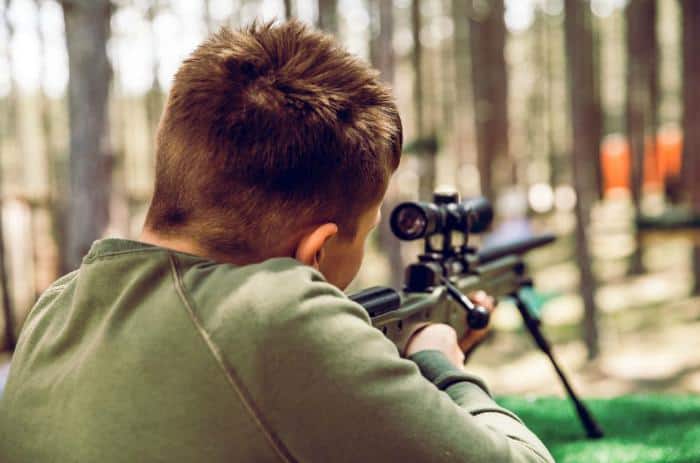
Ways to Reduce the Recoil
In addition to the caliber selection, there are also other steps or approaches that can help negate or reduce the rifle recoil for children. The most common options are these:
- Reduced Recoil Ammunition
- Muzzle brake
- Suppressor
- Upgraded Recoil Pad
Let’s go over each method in more depth and discuss the pros and cons of each:
Reduced Recoil Ammunition
Reduced recoil ammo has become increasingly popular over the years, especially for the big bore rifles with a punishing recoil. These rounds are manufactured or hand loaded with less powder, producing less recoil.

In some cases, the recoil can be reduced by as much as 20%, but the average is closer to a 10% reduction.
Some ammunition manufacturers, like Hornady, even offer commercially made reduced recoil loads specifically designed for hunting whitetails.
It’s also worth noting that most ammunition brands only offer reduced recoil rounds for certain popular calibers, and only one or two calibers on the list above have reduced recoil options.
While reduced recoil loads are certainly an option, here are a few pros and cons:
Pros
- They do provide some reduction in recoil for a new or young shooter.
- They may offer an option to gradually transition a young shooter to a more powerful caliber.
Cons
- The rounds tend to be more expensive than standard rounds.
- They only offer a slight amount of recoil reduction.
- The rounds may not be as powerful or effective on game as the traditional rounds (although Hornady has indicated that the difference in the terminal ballistics between a regular round and a reduced recoil round is minimal).
Muzzle Brake
A muzzle brake is a device that attaches to the end of a rifle barrel and is designed to port or direct a percentage of the gases generated during ignition away from the muzzle.
By diverting the gases expelled as the round is fired, the recoil can be reduced by as much as 35% to 40%. Typically, you only see muzzle brakes on higher-powered or magnums, but, in theory, you could potentially add one to any of the calibers on this list. (However, before you do, please read this entire section on muzzle brakes).
While muzzle brakes effectively reduce recoil, I’m not a fan of this approach because muzzle brakes amplify the gunfire sound back toward the shooter. In addition, muzzle brakes also cause the shooter to feel the concussive force of the blast more on their face.
For these reasons, I typically don’t recommend brakes as an option for young or new shooters. Even with good-quality hearing protection, the combination of the increased noise and increased concussive force is typically scarier than the recoil. This phenomenon seems to be especially true with kids under the age of 12.
I’ve even somewhat tested the theory by asking kids to shoot a 243 with and without a muzzle brake and then seeing which they preferred. Even though the muzzle brake did reduce the recoil, 99% of the kids who did the test shots chose the no-muzzle brake option over the with muzzle brake option.
Pros
- It can reduce the felt recoil anywhere from 35 to 40%.
- With a threaded muzzle, applying a brake can be a simple process.
Cons
- Amplifies the gunfire sound back towards the shooter.
- Amplifies the concussive force that the shooter feels from the shot being fired.
- Reduces the power of the bullet as it travels down range.
Suppressor
A suppressor (also called a silencer or can) is a tubular device with internal baffles designed to reduce the sound of the muzzle blast when a firearm discharges. The baffles slow down the gases generated from the round detonation, which reduces the sound at the muzzle and downrange (to a point).
Mounting an appropriate caliber suppressor to a rifle can reduce the amount of recoil by 25% to 30%. In addition, the sound generated at the muzzle can be reduced anywhere from 30% to 50%.
Suppressors are caliber specific, so a 6.5 Grendel or 6.5 Creedmoor requires a .30 caliber suppressor. A caliber with smaller dimensions can be fired through a larger caliber suppressor, but the sound reduction isn’t as effective. For example, a .30 caliber suppressor can be successfully mounted on a 5.56 AR-15, but the sound suppression won’t be as effective as a 5.56 rated suppressor mounted on a 5.56 caliber rifle.
However, suppressors come with pros and cons, including:
Pros
- It can reduce the recoil by 25 to 30%.
- It can reduce the sound of the shot by 30 to 50%.
- Typically, it doesn’t adversely impact the rifle’s accuracy, especially at distances of 200 yards or less.
Cons
- Suppressors are not legal in every state.
- Suppressors fall under the National Firearms Act, requiring a specific application process and special tax stamp to possess legally. The tax stamp alone is $200.
- They can be an expensive option as the cost of ownership includes the price of the suppressor and the tax stamp.
- They are caliber specific based on the overall caliber family. For example, most 30-caliber cartridges require a .30-caliber can.
- A suppressor can change the point of impact on a rifle, so the rifle has to be sighted in with the suppressor mounted.
I live in a state where suppressors are legal, so I’m a big fan of using a suppressor on rifles with kids. Even though there’s a cost factor involved, the combination of reduced recoil, reduced noise, and overall cool factor for the kids makes the cost worthwhile (plus I like them for my own use).
Upgraded Recoil Pad
Another option for reducing the rifle recoil involves adding a better or more padded recoil pad to the rifle butt. A good quality recoil pad can reduce the felt recoil by 5-7%, which isn’t bad for the cost.
Pads are available in models that just slip on over the existing recoil pad and models that may require mounting by a gunsmith.
Aside from reduced recoil loads, upgrading the recoil pad on a rifle is the next most economical method of recoil reduction.

FAQS
Here are some commonly asked questions that are associated with rifle calibers for young deer hunters:
What’s the best low recoil deer rifle?
Opinions will always vary on that topic, but the Winchester .243 is an excellent option for deer with a low recoil of about 9.5 ft-lbs. of energy. For comparison purposes, that 9.5 ft-lbs. of recoil with the 243 is almost half the recoil of the average 12 gauge shotgun. In addition, the 243 offers excellent ballistics for deer, and 243 ammunition is easy to find at any gun store or hunting store.
Is a shotgun a good choice as a first deer gun for a child?
Shotguns certainly have their place in deer hunting and are a better option than rifles in some situations. For example, if you’re hunting deer with dogs or hounds, you’ll be more successful with a shotgun and buckshot than with a rifle because the deer are always on the run. Or, if you’re hunting in a state that doesn’t allow rifles, then a shotgun is your only firearms option.
However, under most circumstances, I prefer a rifle over a shotgun for kids and youngsters. I say that for two reasons: (1) 00 buckshot (which is very popular for kids) is a short-range option at best, and (2) the recoil from most shotguns exceeds the recoil of several excellent deer cartridges.
For example, the average 20-gauge shotgun running 00 buckshot generates between 18 and 19 ft-lbs. of recoil. That recoil number is greater than the average recoil numbers for the average Winchester 243 and 6.5 Creedmoor rifles, and both of those are excellent deer hunting calibers.
What’s the best deer rifle for 10 year old?
If you posed this question to ten different fathers who hunt, I bet you would get ten different answers.
For me, the answer varies depending on several factors, including:
- The child’s level of shooting experience
- Recoil sensitivity
With a 10-year-old, I would lean towards either a single-shot rifle like a New England Handi-rifle chambered in either .300 Blackout, .350 Legend, or possibly 6.5 Grendel. All three of those calibers have a very mild recoil (as in less than 7 foot-pounds of recoil), and all are capable short-range deer calibers with the proper ammunition.
While I prefer a single shot in that situation, you could also use a bolt action as well. However, I find that the single-shot option is very safe from a gun handling perspective, and most ten years old are not going to be able to accurately get off a follow-up shot anyway if they miss.
What’s the best beginner deer rifle caliber?
There are several excellent rifle cartridges on the market that are excellent options as a first deer rifle for a beginner. However, if I had to recommend just one caliber as being the “best,” I would have to lean towards the .243 Winchester due to its low recoil, terminal ballistics on deer-sized game, ammo options and availability, and the number of rifle options chambered in the caliber.
Plus, the .243 is versatile enough for use on other species, including wild pigs, varmints, mule deer, and even elk or black bears with the right load.
Hopefully, you found this information helpful when it comes to choosing a recoil-friendly caliber for a child, kid, or teen who’s just getting started deer hunting.
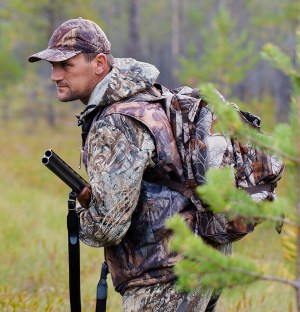
Born and raised in the North Carolina foothills, Andy was introduced to the outdoors at a very young age. Like most beginning hunters, he started out hunting small game like rabbits and squirrels, then graduated to larger species like Whitetail Deer. Although he’s an avid deer and turkey hunter, he still enjoys hunting small game as well. Andy has worked in the hunting and fishing industry for nearly 25 years.


